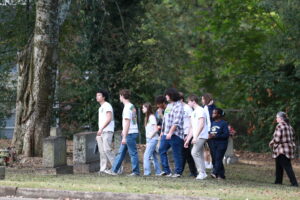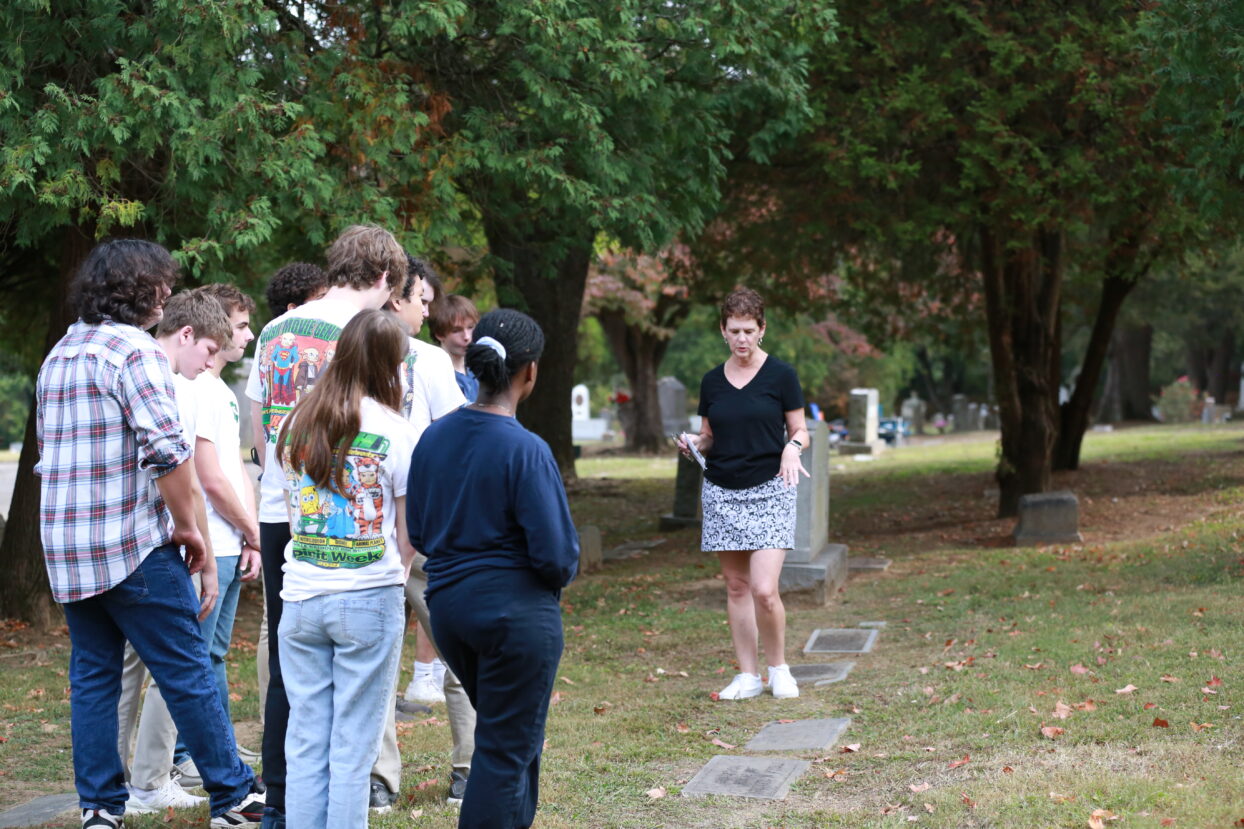Students learn that care for departed, their burial grounds are part of Christian life
By Emily Booker
A burial ground, be it a cemetery, mausoleum, or columbarium, is an important part of a Catholic community.
The Catechism says, “The bodies of the dead must be treated with respect and charity, in faith and hope of the resurrection. The burial of the dead is a corporal work of mercy (Tobit 1:16-18); it honors the children of God, who are temples of the Holy Spirit” (Catechism of the Catholic Church, 2300).

The names of longtime Catholic families in East Tennessee can be found on gravestones in Calvary and Mount Olivet. (Credit Pam Rhoades / KCHS)
Remembering those before us
The small but growing and faithful Catholic community in Knoxville in the 1800s understood the importance of a consecrated burial ground for their loved ones when they bought six acres of land a couple of miles east of Immaculate Conception Church and established Calvary Cemetery in 1869.
The dedication of the cemetery shows how much the parishioners valued and respected having this place to properly bury their Catholic brothers and sisters.
On Oct. 3, 1869, Bishop Patrick A. Feehan of the Diocese of Nashville consecrated Calvary Cemetery in Knoxville.
According to an Oct. 5, 1869, Knoxville Daily Press and Herald report of the events, Bishop Feehan celebrated Mass at Immaculate Conception in the morning. In the afternoon, a procession moved from the church to the cemetery, about a two-mile route.
From the Knoxville Daily Press and Herald:
“Headed by the Knoxville Brass Band, left the church grounds at about half past 2 o’clock. First came the Right [….] Bishop of the Diocese, P. A. Feehan and Father Finnegan, both of whom were dressed in the ecclesiastical costume. They were followed by the Acolytes, who were clad in their red Cossacks [sic]and surplices, led by the choir attached to the Church of the Immaculate Conception. These were followed by a large train of beautiful girls, who were dressed in white and wore green sashes. Next came the boys and the different societies; and lastly, those in carriages and other vehicles. The scene, while bearing all the semblance of religious devotion, was, nevertheless, exceedingly picturesque; the band discoursed beautiful music, upturned faces appeared in every direction along the street, and anxious faces looked down from every window and balcony.”
Once at the cemetery, five crosses fixed in different parts of the six acres of burial grounds were incensed and prayers said at each one. The grounds of the cemetery were blessed with holy water.
According the paper’s report, Bishop Feehan spoke of the reverence and respect we should have for the dead and for the place of their repose.
“Death was no destruction, no annihilation, for the Christian looked forward to a blessed and glorious resurrection. The Bishop’s language was chaste and refined throughout—at times it was really sublime—it was always logical and substantial,” the paper reported.
Several Catholics were relocated from the local Gray Cemetery and reburied in the new cemetery. The first recorded burial was that of an infant child of Daniel Kay in 1869. Calvary would soon become the place for generations of Catholics to be laid to rest and remembered.
Care and remembrance
More than 150 years later, Calvary Cemetery remains the only Catholic burial ground in the greater Knoxville area. It is still maintained by Immaculate Conception Parish.
“There’s a core group of parishioners. It’s wonderful. A lot of them have great-great grandparents and parents and grandparents all buried there,” Father Charlie Donahue, CSP, pastor of Immaculate Conception, said of he parish cemetery committee.
The committee does a monthly cleanup in the cemetery and coordinates for professional mowers and groundskeepers. The committee also works to maintain the tombstones, especially the older ones, which can shift in the soft soil or require delicate cleaning.
Members are working to digitize burial records as well as identify all the veterans buried there.

KCHS senior Patrick Barry stands next to a gravestone for his ancestors. (Credit Pam Rhoades / KCHS)
While many parishioners of Immaculate Conception have family members buried in the cemetery, the committee makes sure that every grave there is respected and taken care of.
“It’s a part of who we are,” Father Donahue said. “I think especially as Catholics in Knoxville, areas where our grandparents, great-grandparents may have had in their life experience being kind of shunned by polite society because they were Catholic. So, there is kind of a sense of a kind of solidarity… to be of service and help.”
As part of its care over Calvary Cemetery, Immaculate Conception Parish holds a Memorial Day Mass and a rosary around All Souls Day there every year. The tradition of praying the rosary at Calvary Cemetery for All Souls’ Day goes back to 1899.
Parishioners also offer tours of the cemetery afterward to those who want to learn more about the grounds and the Catholic history of Knoxville.
On Oct. 5, 11 Knoxville Catholic High School students of Dr. Michelle Weedman’s Christian Pilgrimage class took a field trip to Calvary Catholic Cemetery to learn about Catholic ancestry in Knoxville.
“Pilgrimage is an experience of the faith,” Dr. Weedman said. “It immerses you actively participating. Pilgrimage is a deep part of our tradition.”
By taking a pilgrimage to the cemetery, the students were able to contemplate on what the Church truly teaches about death, resurrection, and the communion of saints. For some, it was the first time they had visited a cemetery outside of a burial service.
“It was about introducing them to this sacred space, how we live out our doctrines, the communion of saints, remembering them as part of the Church, the Body of Christ,” Dr. Weedman said.
Father Tim Sullivan, CSP, celebrated Mass, and Beth Willard Wolf of the cemetery committee taught the students more about Calvary.
Notable burials
Some notable burials in Calvary include railroad contractor George Callahan (brother of Father Emmanuel Callahan, who began several missions in East Tennessee); Knoxville mayor and state representative John Paul Murphy; and the brothers Barney and Ally Harman, inventors of the popular soft drink Mountain Dew.
Priests Circle is the resting place for many of Knoxville’s priests, including several priests who came from Ireland to serve the scattered immigrant populations in Tennessee.
One of the earliest burials in Calvary was that of Robert Canovan, a seminarian who died at age 27 in 1869. Although he never reached ordination, he is honored for answering God’s call and rests in Priests Circle.
Monsignor Xavier Mankel, who helped found the Diocese of Knoxville, is buried in Calvary along with other members of the Mankel family. Rather than being buried in Priests Circle, Monsignor Mankel selected a particular spot under a tree.

Dr. Michelle Weedman, who leads a Christian Pilgrimage class at Knoxville Catholic High School, guides her students through Calvary Cemetery in Knoxville, which dates to 1869 and is one of only two Catholic cemeteries in East Tennessee. (Credit Pam Rhoades / KCHS)
These are just some of the many souls who are buried at Calvary and whose legacies continued to be remembered by family and the community.
The KCHS students laid a wreath in the school’s colors in the cemetery “in honor and memory of faithful before us whose footsteps we follow,” Dr. Weedman explained. A couple of students also laid flowers at family member’s graves.
Students also learned about the work it takes to maintain burial grounds and spent the afternoon in service raking and bagging leaves.
With All Saints’ Day on Nov. 1 and All Souls’ Day on Nov. 2, November is the month when many people remember past loved ones, pray for the dead, and visit burial grounds.
Physically visiting sacred burial ground is a good way to remember the generations of faithful who paved the way before us, ponder our own mortality, and place our faith in the hope of the resurrection.
In Christ there is no death. Christians are called to pray for the souls of the faithful departed, and, in turn, those in heaven—the communion of saints—pray for those still running the race here and now.
Calvary Cemetery is located at 1916 Martin Luther King Jr. Ave. in Knoxville.
Mount Olivet Cemetery, which opened in 1886, similarly serves the Chattanooga Catholic community. It is located at 1 Mount Olivet Drive in Chattanooga. Go to www.mountolivet.net for more information.

